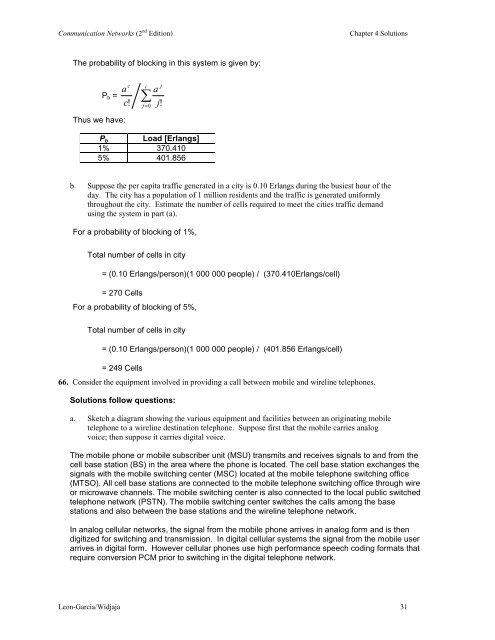Solutions to Chapter 4 - Communication Networks
Solutions to Chapter 4 - Communication Networks
Solutions to Chapter 4 - Communication Networks
Create successful ePaper yourself
Turn your PDF publications into a flip-book with our unique Google optimized e-Paper software.
<strong>Communication</strong> <strong>Networks</strong> (2 nd Edition)<br />
<strong>Chapter</strong> 4 <strong>Solutions</strong><br />
The probability of blocking in this system is given by:<br />
P b =<br />
c<br />
a<br />
c!<br />
c<br />
<br />
a<br />
j<br />
j<br />
j=<br />
0 !<br />
Thus we have:<br />
P b Load [Erlangs]<br />
1% 370.410<br />
5% 401.856<br />
b. Suppose the per capita traffic generated in a city is 0.10 Erlangs during the busiest hour of the<br />
day. The city has a population of 1 million residents and the traffic is generated uniformly<br />
throughout the city. Estimate the number of cells required <strong>to</strong> meet the cities traffic demand<br />
using the system in part (a).<br />
For a probability of blocking of 1%,<br />
Total number of cells in city<br />
= (0.10 Erlangs/person)(1 000 000 people) / (370.410Erlangs/cell)<br />
= 270 Cells<br />
For a probability of blocking of 5%,<br />
Total number of cells in city<br />
= (0.10 Erlangs/person)(1 000 000 people) / (401.856 Erlangs/cell)<br />
= 249 Cells<br />
66. Consider the equipment involved in providing a call between mobile and wireline telephones.<br />
<strong>Solutions</strong> follow questions:<br />
a. Sketch a diagram showing the various equipment and facilities between an originating mobile<br />
telephone <strong>to</strong> a wireline destination telephone. Suppose first that the mobile carries analog<br />
voice; then suppose it carries digital voice.<br />
The mobile phone or mobile subscriber unit (MSU) transmits and receives signals <strong>to</strong> and from the<br />
cell base station (BS) in the area where the phone is located. The cell base station exchanges the<br />
signals with the mobile switching center (MSC) located at the mobile telephone switching office<br />
(MTSO). All cell base stations are connected <strong>to</strong> the mobile telephone switching office through wire<br />
or microwave channels. The mobile switching center is also connected <strong>to</strong> the local public switched<br />
telephone network (PSTN). The mobile switching center switches the calls among the base<br />
stations and also between the base stations and the wireline telephone network.<br />
In analog cellular networks, the signal from the mobile phone arrives in analog form and is then<br />
digitized for switching and transmission. In digital cellular systems the signal from the mobile user<br />
arrives in digital form. However cellular phones use high performance speech coding formats that<br />
require conversion PCM prior <strong>to</strong> switching in the digital telephone network.<br />
Leon-Garcia/Widjaja 31







